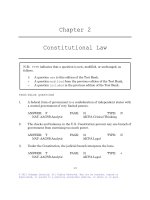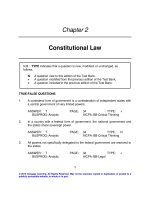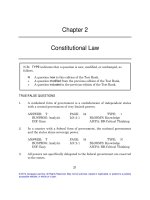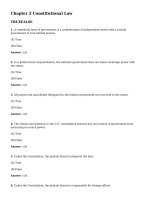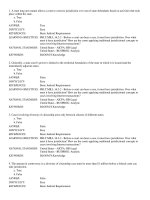Bus law today 9th ed ch21
Bạn đang xem bản rút gọn của tài liệu. Xem và tải ngay bản đầy đủ của tài liệu tại đây (594.89 KB, 30 trang )
BUSINESS LAW TODAY
Essentials 9th Ed.
Roger LeRoy Miller - Institute for University Studies, Arlington, Texas
Gaylord A. Jentz - University of Texas at Austin, Emeritus
Chapter
21
Investor Protection,
Insider Trading, and
Corporate Governance
© 2011 Cengage Learning. All Rights Reserved. May not be copied, scanned, or duplicated, in whole or in part, except for use as permitted in
a license distributed with a certain product or service or otherwise on a password-protected website for classroom use.
1
Learning Objectives
What is meant by the term securities?
What are the two major statutes regulating
the securities industry?
What is insider trading? Why is it prohibited?
What are some of the features of state
securities laws?
What certification requirements does the
Sarbanes-Oxley Act impose on corporate
executives?
© 2011 Cengage Learning. All Rights Reserved. May not be copied, scanned, or duplicated, in whole or in part, except for use as permitted in
a license distributed with a certain product or service or otherwise on a password-protected website for classroom use.
2
Securities and Exchange
Commission
Major Responsibilities of the SEC:
Require disclosure of facts concerning
offerings.
Regulate trade in securities.
Investigate securities fraud.
Regulate activities of securities brokers,
dealers, and investment advisors.
Supervise mutual fund activities.
Recommend sanctions for violations.
© 2011 Cengage Learning. All Rights Reserved. May not be copied, scanned, or duplicated, in whole or in part, except for use as permitted in
a license distributed with a certain product or service or otherwise on a password-protected website for classroom use.
3
Securities Act of 1933
The Securities Act of 1933 governs the
initial sale of stocks by businesses.
Designed to protect investors from
deceptive, unfair and manipulative
practices when buying or selling
securities.
Securities are instruments such as
corporate stock or limited partnership
interests that evidence ownership or debt.
© 2011 Cengage Learning. All Rights Reserved. May not be copied, scanned, or duplicated, in whole or in part, except for use as permitted in
a license distributed with a certain product or service or otherwise on a password-protected website for classroom use.
4
What is a Security?
In SEC v. Howey (1946), the U.S. Supreme
Court held that a security (investment
contract) exists in any transaction in
which a person: (1) invests (2) in a
common enterprise (3) reasonably
expecting profits (4) derived primarily
from others’ managerial or entrepreneurial
efforts.
© 2011 Cengage Learning. All Rights Reserved. May not be copied, scanned, or duplicated, in whole or in part, except for use as permitted in
a license distributed with a certain product or service or otherwise on a password-protected website for classroom use.
5
Registration Statement
If a security does not qualify for an
exemption under §5 of the Securities Act
of 1933, the security must be registered
with the Securities Exchange Commission
() and state securities
agencies before offered to the public.
Corporation must file a registration
statement and prospectus with the SEC.
Prospectus is later distributed to
investors.
© 2011 Cengage Learning. All Rights Reserved. May not be copied, scanned, or duplicated, in whole or in part, except for use as permitted in
a license distributed with a certain product or service or otherwise on a password-protected website for classroom use.
6
Registration Statement
Description of the significant
provisions of the registrant’s
“offering” and how the registrant
intends to use the proceeds from the
sale.
Description of the registrant’s
properties and business.
© 2011 Cengage Learning. All Rights Reserved. May not be copied, scanned, or duplicated, in whole or in part, except for use as permitted in
a license distributed with a certain product or service or otherwise on a password-protected website for classroom use.
7
Registration Statement
Description of the management of
the registrant, remuneration,
pension, stock offerings, executive
interests and compensation.
Financial statement certified by and
independent accounting firm.
Description of pending lawsuits.
© 2011 Cengage Learning. All Rights Reserved. May not be copied, scanned, or duplicated, in whole or in part, except for use as permitted in
a license distributed with a certain product or service or otherwise on a password-protected website for classroom use.
8
Registration Process
Registration statement does not become
effective until approval by SEC.
Pre-Filing Period: issuer cannot offer or sell
securities.
Waiting Period: securities can be offered by
not sold. 2005: Free-writing prospectus.
Post-Effective Period: registration
effective 20 days after approval.
© 2011 Cengage Learning. All Rights Reserved. May not be copied, scanned, or duplicated, in whole or in part, except for use as permitted in
a license distributed with a certain product or service or otherwise on a password-protected website for classroom use.
9
Exempt Securities and
Transactions
Bank securities sold before 1933.
Commercial paper if maturity date
does not exceed 9 months.
Charitable organization securities.
Securities issued to existing
securities holders resulting from
reorganization, bankruptcy.
Securities issued to finance railroad
equipment.
© 2011 Cengage Learning. All Rights Reserved. May not be copied, scanned, or duplicated, in whole or in part, except for use as permitted in
a license distributed with a certain product or service or otherwise on a password-protected website for classroom use.
10
Exempt Securities
Any insurance, endowment, annuity
contract or government-issued
securities.
Securities issued by banks, savings
and loan association, farmers'
cooperatives.
Securities issued to existing
securities holders, stock split,
dividend (really a transaction
exemption).
© 2011 Cengage Learning. All Rights Reserved. May not be copied, scanned, or duplicated, in whole or in part, except for use as permitted in
a license distributed with a certain product or service or otherwise on a password-protected website for classroom use.
11
Exempt Transactions
Regulation A Offerings: small
offering up to $5 million in a 12
month period to “test the waters”;
but requires a circular.
© 2011 Cengage Learning. All Rights Reserved. May not be copied, scanned, or duplicated, in whole or in part, except for use as permitted in
a license distributed with a certain product or service or otherwise on a password-protected website for classroom use.
12
Exempt Transactions
Small Offerings: Regulation D.
Rule 504: up to $1M during 12 months to
accredited investors only.
Rule 504a.
Rule 505: private, up to $5M during 12
months to both accredited and
unaccredited investors.
Rule 506: “private placement” exemption:
unlimited amounts, not advertised, to
accredited investors only.
© 2011 Cengage Learning. All Rights Reserved. May not be copied, scanned, or duplicated, in whole or in part, except for use as permitted in
a license distributed with a certain product or service or otherwise on a password-protected website for classroom use.
13
Exempt Transactions
Section 4(6): up to $5M solely to
accredited investors.
Intrastate Offerings—Rule 147.
Rule 144.
Rule 144a.
© 2011 Cengage Learning. All Rights Reserved. May not be copied, scanned, or duplicated, in whole or in part, except for use as permitted in
a license distributed with a certain product or service or otherwise on a password-protected website for classroom use.
14
© 2011 Cengage Learning. All Rights Reserved. May not be copied, scanned, or duplicated, in whole or in part, except for use as permitted in
a license distributed with a certain product or service or otherwise on a password-protected website for classroom use.
15
Violations of the 1933 Act
Intentional or negligent fraud of investors by
misrepresenting or omitting material facts in
the registration statement and/prospectus.
Defenses: Statement left out was not material;
Plaintiff knew about fraud and purchased
stock; Registrant believed statements were
true.
Penalties:
Criminal: up to 5 years in prison and $10,000 fine.
Civil: damages, refund of investment, injunction.
© 2011 Cengage Learning. All Rights Reserved. May not be copied, scanned, or duplicated, in whole or in part, except for use as permitted in
a license distributed with a certain product or service or otherwise on a password-protected website for classroom use.
16
Securities Exchange Act of
1934
Registration of securities exchanges,
brokers, dealers, and national securities
exchanges and associations.
Requires continuous disclosure system
for corporations with securities sold on
national exchanges or assets in excess
of $10 million and 500 or more
shareholders (Sec. 12 companies or
1934 companies).
© 2011 Cengage Learning. All Rights Reserved. May not be copied, scanned, or duplicated, in whole or in part, except for use as permitted in
a license distributed with a certain product or service or otherwise on a password-protected website for classroom use.
17
Section 10(b) and Rule 10b(5)
& Insider Trading
Section 10(b) prohibits the use of any
manipulative or deceptive device or
contrivance in contravention of rules
and regulations of SEC.
Rule 10b(5) prohibits the commission
of fraud in the connection with the
purchase or sale of any security.
© 2011 Cengage Learning. All Rights Reserved. May not be copied, scanned, or duplicated, in whole or in part, except for use as permitted in
a license distributed with a certain product or service or otherwise on a password-protected website for classroom use.
18
Section 10(b) and Rule 10b(5)
& Insider Trading
Insider Trading
Advance information available to corporate
officers and directors that can affect future
value of stock.
Insider trading prohibited:
10b(5) “Insiders” (Officers, Executives and
Directors).
© 2011 Cengage Learning. All Rights Reserved. May not be copied, scanned, or duplicated, in whole or in part, except for use as permitted in
a license distributed with a certain product or service or otherwise on a password-protected website for classroom use.
19
Disclosure under SEC Rule 10b5
Material omission or misrepresentation may
violate 1933 Act and antifraud provisions of
1934 Act and SEC Rule 10b-5.
Key is whether insider’s information is
“material”, such as:
Fraudulent trading by broker-dealer, dividend change,
contract for sale of corporate assets, new discovery,
process, or product, significant change in financial
condition, potential litigation.
CASE 21.1
SEC v. Texas Gulf Sulphur, Inc.
(1968). Officers and employees engaged in insider
trading. The test of materiality is what would affect
the judgment of reasonable investors.
© 2011 Cengage Learning. All Rights Reserved. May not be copied, scanned, or duplicated, in whole or in part, except for use as permitted in
a license distributed with a certain product or service or otherwise on a password-protected website for classroom use.
20
Private Securities Litigation
Reform Act of 1995
Provides “safe harbor” for publicly
held companies that make forwardlooking statements, such as financial
forecasts.
Protection against liability from
securities fraud with “meaningful
cautionary statements.”
© 2011 Cengage Learning. All Rights Reserved. May not be copied, scanned, or duplicated, in whole or in part, except for use as permitted in
a license distributed with a certain product or service or otherwise on a password-protected website for classroom use.
21
Outsiders and SEC Rule 10b-5
Outsiders and SEC Rule 10b(5):
Tipper/tippee theory--insider’s fiduciary duty must be
breached.
Misappropriation theory -- one wrongfully obtains inside
info and trades on it -- Courts still require fiduciary duty
be breached, to employer, for instance.
What about “scheme” liability?
CASE 21.2 Stoneridge Investment Partners, LLC v.
Scientific-Atlanta, Inc. (2008). Court dismissed claims
against Scientific Atlanta and Motorola – Section 10(b)
private right of action cannot be applied to “outsiders”
(customers or suppliers).
© 2011 Cengage Learning. All Rights Reserved. May not be copied, scanned, or duplicated, in whole or in part, except for use as permitted in
a license distributed with a certain product or service or otherwise on a password-protected website for classroom use.
22
Insider Reporting and Trading
—Section 16(b)
Section 16(b).
Recapture by corporation of profits during
previous six months gained by insider trading.
Applies to stocks, warrants, options and
convertible securities.
Regulation of Proxy Statements, Sect.
14(a).
Whoever solicits a proxy must fully disclose all
of the facts and which shareholders must vote.
© 2011 Cengage Learning. All Rights Reserved. May not be copied, scanned, or duplicated, in whole or in part, except for use as permitted in
a license distributed with a certain product or service or otherwise on a password-protected website for classroom use.
23
Comparison of 10b-5 and 16(b)
© 2011 Cengage Learning. All Rights Reserved. May not be copied, scanned, or duplicated, in whole or in part, except for use as permitted in
a license distributed with a certain product or service or otherwise on a password-protected website for classroom use.
24
Violations of the 1934 Act
10(b) and 10B-5: scienter is required, proved by
showing defendant made false statements or
wrongfully failed to disclose material facts. 16(b):
strict liability -- no fault or scienter required.
Criminal Penalties: Individuals-imprisonment up to
10 years, fines up to $5 million, $2.5 for partnership
or corporation.
Civil Sanctions.
CASE 21.3 Stark Trading v. Falconbridge, Ltd. (2009).
Stark’s 10(b) claim was dismissed because he was aware
of the misrepresentations before he bought the stock.
Therefore the reliance element was missing.
© 2011 Cengage Learning. All Rights Reserved. May not be copied, scanned, or duplicated, in whole or in part, except for use as permitted in
a license distributed with a certain product or service or otherwise on a password-protected website for classroom use.
25




